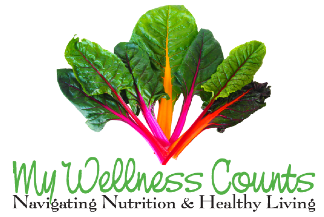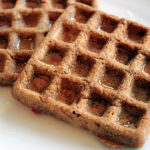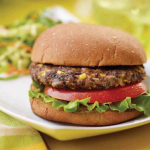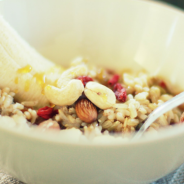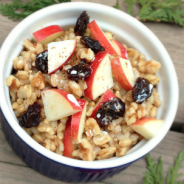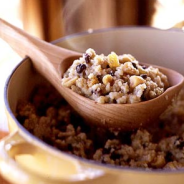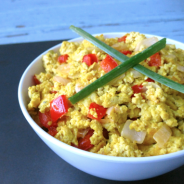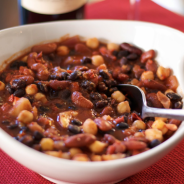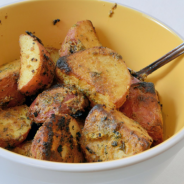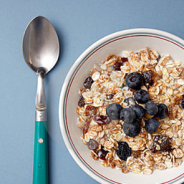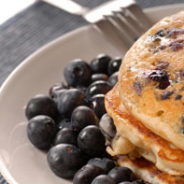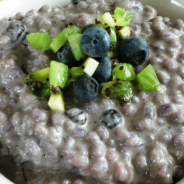Healthy Recipes
PCRM Food For Life Recipes
Certified Food For Life Cooking Instructor, Sari Dennis is also a Board Certified Health and Wellness Counselor, and Founder of My Wellness Counts, LLC. Sari works with professionalism and compassion, guiding her clients to prioritize their health by connecting sound nutrition with healthy lifestyle choices. Sari advocates the value of nutritional excellence as a path to vibrant health and happiness.
“Healthy surroundings create healthy thoughts, and healthy thoughts inspire healthy choices.”
Sari works in group-settings and one-on-one with individual clients, over the course of a 6-month period. Sari received her training at the Physicians Committee For Responsible Medicine and at the Institute for Integrative Nutrition in NYC. Sari is certified by Purchase College of the State University of New York (SUNY), and accredited through the American Association of Drugless Practitioners (AADP).
Below you will find easy ways to REPLACE your allergy-sensitive ingredients for healthy, plant-based options . . . so keep reading!
All recipes are 100% plant-based, and here are some of the many health related reasons why:
20 Quotes from the Experts
1. “Genetics loads the gun, lifestyle pulls the trigger.” – Caldwell Esselstyn, Jr., MD
2. “They say that vegetable food is not sufficiently nutritious. But chemistry proves contrary. So does physiology. So does experience…And again: the largest and strongest animals in the world are those which eat no flesh-food of any kind – the elephant and rhinoceros.” Russell Trall, MD
3. “It is the position of the American Dietetic Association that appropriately planned vegetarian diets, including total vegetarian or vegan diets are healthful, nutritionally adequate, and may provide health benefits in prevention and treatment of certain diseases.” ADA Position on Vegetarian Diets 2009
4. “Your choice of diet can influence your long term health prospects more than any other action you might take.” – Former Surgeon General C. Everett Coop
5. “You cannot buy health; you must earn it through healthy living.” – Joel Furhman, MD
6. “We have science to suggest that if you can make three changes – give up meat, all dairy, and refined foods including free oils – you can avoid dying form cancer and heart disease.” Mehmet Oz, MD
7. “People feel poorly because they are nourished by foods you wouldn’t feed to your dog or cat. The rich western diet is full of fat, sugar, cholesterol, salt, animal protein — all the wrong foods for people. Look around the world and see where people are thin and healthy — they live on a starch based diet — rice.” – John McDougall, MD
8. “Heart disease is a food-borne illness.” – Caldwell Esselstyn, Jr., MD
9. “In this diet you’re never hungry. You never have to count calories. Its like quitting smoking, you don’t eat meat for a while and it’s hard for the first day or two, but (it’s easier) after you focus on the new foods you’re eating.” – Neal Barnard, MD
10. “A plant-based diet is more likely to produce good health and to reduce sharply the risk of heart problems, cancer, diabetes, osteoporosis, gallstones, and kidney disease.” – T. Colin Campbell, PhD
11. “An important fact to remember is that all natural diets, including purely vegetarian diets without a hint of dairy products, contain amounts of calcium that are above the threshold for meeting your nutritional needs…In fact, calcium deficiency caused by an insufficient amount of calcium in the diet is not known to occur in humans.” – John McDougall, MD
12. “We should all be eating fruits and vegetables as if our lives depend on it – because they do.” – Michael Greger, MD
13. “…in switching over to a plant-based diet, most people are able to reverse their heat disease, cure type II or significantly improve type I diabetes, effortlessly reduce their weight, eliminate their chronic and nagging aches and pains.” – Alona Pulde, MD and Matthew Lederman, MD
14. “I don’t understand why asking people to eat a well-balanced vegetarian diet is considered drastic while it is medically conservative to cut people open or put them on powerful cholesterol-lowering drugs the rest of their lives.” – Dean Ornish, MD
15. “We believe that if people focus on what they’re eating and not how much they’re eating, they will have weight loss with a plant-based diet.” – Neal Barnard, MD
16. “In the next ten years, one of the things you’re bound to hear is that animal protein is one of the most toxic nutrients of all that can be considered. Quite simply the more you substitute plant foods for animal foods, the healthier you are likely to be.” – T. Colin Campbell, PhD
17. “Medicines cannot drug away the cellular defects that develop in response to improper nutrition throughout life.” – Joel Furhman, MD
18. “Poor nutrition trumps tobacco, alcohol, and sedentary lifestyles as the primary cause for the development of chronic illnesses. We cannot ignore the reality that what we eat is totally within our control, and our choices are what determine the level of risk we have of becoming ill.” – Baxter Montgomery, MD
19. “The beef industry has contributed to more American deaths than all the wars of this century, all natural disasters, and all automobile accidents combined. If beef is your idea of “real food for real people” you’d better live real close to a real good hospital.” – Neal Barnard, MD
20. “Numerous research studies have shown that cancer is more common in populations consuming diets rich in fatty foods, particularly meat, and much less common in countries with diets rich in grains, vegetables, and fruits.” – Neal Barnard, MD
Bonus: “The fat you eat, is the fat you wear.” – John McDougall, MD
Therefore: eat more plants!
Replacing Allergy-Sensitive Ingredients
The following is a rundown of what to use in place of allergenic ingredients, including gluten. These allergen-free standbys are wonderful in the kitchen.
Replacing Eggs
Eggs provide moisture, richness, binding, and leavening. You may choose from a variety of alternate ingredients throughout your recipes in place of eggs.
APPLESAUCE
Applesauce works as a binding agent, and is also a great substitute for eggs or oil/shortening, when you want to reduce the fat. 1/4 cup unsweetened applesauce = 1 egg
BANANA
Works similarly to applesauce, but has a much more distinct flavor. Only use it when you want to taste banana. 1/2 a mashed banana = 1 egg
PRUNE PUREE (AKA, baby food!)
Again, works similarly to applesauce, with a sweeter flavor. 4 1/2 to 5 ounce jar = 1 egg
VEGAN YOGURT
Vegan yogurt is great for adding moisture and binding. You may use it in place of eggs, but also in place of buttermilk, or cream. Also, coconut milk yogurt (see notes below re: coconut), and rice milk yogurt. Most people with tree nut allergies are NOT allergic to coconut, it’s an extremely rare allergy, but still, check with your allergist before consuming it. If the coconut milk is not an option for you, use the rice milk yogurt instead. 1/4 cup vegan yogurt = 1 egg
FLAXSEED MEAL
I love the effect of “flax eggs”, it works just like an egg, doing everything but leavening. It’s moist, rich, and binding. However, use “flax eggs” sparingly, as it is difficult to find totally clean flax. It’s often processed in facilities along with tree nuts or other allergens. So be sure to check with the manufacturer before consuming flax if cross contamination is a concern for you. 1 tablespoon Flax Seed Meal mixed with 3 tablespoons warm water = 1 egg
EGG REPLACER
Egg Replacer is great for leavening and binding. Ener-G Egg Replacer is manufactured in a facility free of all common allergens. 1 1/2 teaspoons Ener-G Egg Replacer mixed with 2 tablespoons rice milk or water = 1 egg
BAKING SODA & VINEGAR
This is an old baking trick from WWII when eggs were rationed. It provides leavening in place of eggs. Add the baking soda to the dry ingredients, and the vinegar to the liquid. Wait to combine the dry and liquid ingredients until the very last minute, as the chemical reaction occurs as soon as the baking soda and vinegar meet, and you must get your goodie straight into the oven! 1 teaspoon baking soda + 1 teaspoon cider vinegar (or distilled white vinegar) = 1 egg
Replacing Dairy
Replacing cow milk is pretty much a no-brainer since even our local supermarkets now sell soy milk, hemp milk, almond milk, pea milk, seed milk, rice milk, coconut milk, etc.
1 cup non-dairy milk = 1 cup cow milk
RICE MILK
Rice milk is generally made from brown rice. It is a little thinner than other nondairy milks, but still provides yummy moistness. Rice milk is commercially available just about everywhere. Be sure to read ingredients carefully, as some rice milk brands contain gluten.
HEMP MILK
Hemp milk is the most nutritious of nondairy milks, and has a rich “nutty” flavor. Look for it at Whole Foods or your local health food store.
COCONUT MILK
Traditional coconut milk is very rich. It can be used in baking, but bare in mind that it is thick and sweet. (Again, the allergy world is on the fence about coconut. Some say it’s a member of the date family, some say it’s a tree nut. Most people with tree nut allergies are not allergic to coconut, it’s an extremely rare allergy, but still, check with your allergist before consuming it).
There is also a new Coconut Milk on the shelves made by Turtle Mountain, that functions like rice milk. It’s a thinner, lower calorie coconut milk, available in the refrigerated section at Whole Foods. It’s amazing for baking and yummy in cereal!
INSTEAD OF BUTTERMILK
You can easily make your own nondairy buttermilk at home. For any 1 cup of buttermilk, add 1 tablespoon lemon juice or cider vinegar to 1 cup nondairy milk, and let stand about 10 minutes to sour.
INSTEAD OF YOGURT, CREAM & SOUR CREAM
Use coconut milk yogurt, and rice milk yogurt in place of yogurt, cream, and sour cream. The coconut milk yogurt has a better texture, and the tang of traditional dairy yogurt. If the coconut milk is not an option for you, use the rice milk yogurt instead. And if you can eat soy, then by all means, substitute soy yogurt.
INSTEAD OF BUTTER
Ah, butter, the backbone of western baking. Or is it? I’ve been delighted to find you can still make awesome “buttery” baked goods WITHOUT butter.
DAIRY-FREE, SOY-FREE VEGETABLE SHORTENING
It’s non-hydrogenated, cholesterol free, and bakes up nice and light. 1 cup dairy-free, soy-free vegetable shortening = 1 cup unsalted butter
Replacing Nuts & Nut Butters
SUNBUTTER
The past few years has seen the advent of Sunbutter. Sunbutter (aka, sunflower seed butter) is a great replacement for peanut butter and other nut butters. It is available at Trader Joes, Whole Foods, and many local health food stores. It’s also popping up on some supermarket shelves. Additionally, you can now buy safe sunflower seeds for snacking, or use in baking, though you may have to order these online.
Replacing Wheat Flours & Other Gluten Flours
This is perhaps the trickiest part of baking allergen-free. It’s not so hard to bake gluten-free if you can still use eggs, butter, and nut flours, but learning to bake without ANY of them can be a challenge.
GLUTEN-FREE, ALLERGEN-FREE FLOURS
Rice, Corn, Potato, Tapioca, Beans, Garfava, Sorghum, Quinoa, Millet, Buckwheat, Arrowroot, Amaranth, Teff, Montina, and Flax.
Whoa, that’s a lot of flours! And trickier still, most of them can’t be used on their own, they must be mixed like you’re doing AP chemistry. They can’t be swapped out cup for cup for wheat flour, and they require varying amounts of xanthan from recipe to recipe. So to make things simple for YOU, here is a Basic Gluten-free Flour Mix that you can whip up and store in your fridge:
BASIC GLUTEN-FREE FLOUR MIX (RECIPE)
Makes 6 cups
4 cups superfine brown rice flour
1 1/3 cups potato starch (not potato flour)
2/3 cup tapioca flour (also called tapioca starch)
1. To measure flour, use a large spoon to scoop flour into the measuring cup, then level it off with the back of a knife. Do NOT use the measuring cup itself to scoop your flour when measuring! It will compact the flour and you will wind up with too much for the recipe. Combine all ingredients in a gallon-size Ziploc bag. Shake until well blended. Store in refrigerator until ready to use.
A FEW WORDS ABOUT CHOICE OF FLOURS
When preparing baked goods recipes, do so with a blend of super-fine brown rice flour, potato starch, and tapioca flour. These selected flours/starches are great for gluten-free baking, and they are generally the easiest gluten-free flours for the general public to find. But most importantly, they carry the least risk of cross contamination.
Most gluten-free flours are still being processed in the same facilities as tree nut flours (such as almond flour). These ingredients can be found with the safety assurance that they are free from cross contamination with all common allergens, and which are easily found by the general public.
A FEW WORDS ABOUT EGG REPLACER
Egg replacer works best when whisked together with a liquid, using a small whisk. Be sure to beat it until slightly frothy and all the lumps have dissolved before adding it to a recipe.
A FEW WORDS ABOUT XANTHAN GUM
Xanthan Gum is the be-all and end-all of gluten-free baking. I don’t know what we would do without it. It is a plant gum that mimics gluten. It provides structure and elasticity. A little bit goes a long way, so measure it carefully. I have found there is variation between brands. I like Ener-G Xanthan Gum best. It is a derivative of corn. If you can’t eat corn, you may use guar gum instead, but please note, these recipes have not been tested with guar gum.
Breakfast Grains
Makes 2 servings 2 cups water 1 cup steel-cut oats 1 assorted sliced fruit (optional) Place water and oats in a saucepan. Bring to a boil, reduce heat, and cook for about 10 minutes, stirring occasionally. Top with fruit, if desired. Per serving (1/2 of recipe) Calories: 155 Fat: 2.6 g Saturated Fat: 0.5 g Calories from Fat: 14.8% Cholesterol: 0 mg Protein: 6.5 g Carbohydrates: 27.1 g Sugar: 0.6 g Fiber: 4.3 g Sodium: 6 mg Calcium: 25 mg Iron: 1.7 mg Vitamin C: 0 mg Beta Carotene: 0 mcg Vitamin E: 0.3 mg Source: Mary McDougall of the McDougall Program...
read moreBreakfast Brown Rice
Makes 4 servings Brown rice makes a delicious warm breakfast that will jump-start your day. This recipe calls for soaking the rice overnight. Soaking the rice overnight reduces the normal cooking time considerably, making it convenient for everyday breakfasts. You can pack your lunch, take a shower, or read the paper while it’s steaming. Serve this dish plain or with vanilla soy- or rice milk or a dollop of soy yogurt, if desired. 1 cup dry brown rice 2 cups water 1/4 teaspoon salt (optional) 1 ripe banana, sliced 1 cup chopped fresh fruit or berries 1/4 cup chopped walnuts 1/4 cup raw sunflower or pumpkin seeds 1 fortified vanilla soy- or rice milk or soy yogurt (optional) Place rice in a large wire mesh strainer and rinse well under running water, stirring with your fingers. Place in a large saucepan with the water. Cover and let soak 8 to 22 hours. Do not drain. In the morning, add salt, if using, and bring to a boil. Reduce heat to very low, cover, and cook until tender, about 20 to 30 minutes, or until water is absorbed. If time permits, remove from heat and let rest, covered, 5 to 10 minutes. Top each serving with some of the fruit, nuts, and seeds. Per 1/2-cup serving Calories: 319 Fat: 10.8 g Saturated Fat: 1.2 g Calories from Fat: 30.4% Cholesterol: 0 mg Protein: 7.8 g Carbohydrates: 50.7 g Sugar: 9 g Fiber: 8.1 g Sodium: 9 mg Calcium: 42 mg Iron: 1.6 mg Vitamin C: 13.2 mg Beta Carotene: 27 mcg Vitamin E: 3.4 mg Source: Breaking the Food Seduction by Neal Barnard, M.D.; recipe by Jo Stepaniak; © Jo Stepaniak 2005, published by...
read moreBreakfast Barley with Fruit
Makes 1 serving For delicious taste, lots of soluble fiber, and a wonderfully low glycemic index, try rolled barley (also called barley flakes) for your breakfast porridge. It takes a bit longer to cook than oatmeal unless you soak it the night before. Serve with your favorite non-dairy milk and a touch of brown sugar or the sweetener of your choice. 1/3 cup rolled barley (barley flakes) 1/8 teaspoon salt 3/4 cup water 1 tablespoon wheat bran 1/2 medium apple with peel, , cored and chopped, or other chopped fruit 1 1/2 teaspoons ground flaxseeds The night before: Combine barley, salt, and water in a microwavable bowl, cover, and refrigerate overnight. (Use a 1-quart or larger bowl—barley can really boil up!) In the morning: Add bran and apple or other fruit to soaked barley. Cover the bowl with a microwavable plate and microwave on high for 2 minutes. Finish cooking on medium power for 4 minutes. Stir in flaxseeds. To cook on the stovetop: Bring soaked barley, bran, and apple or other fruit to a boil in a small non-stick saucepan over high heat, stirring. Reduce the heat to low, partially cover, and simmer for about 15 minutes, stirring occasionally. The mixture should have the consistency of cooked oatmeal. If it’s too watery, continue cooking over low heat to desired consistency. Stir in flaxseeds. Per serving Calories: 174 Fat: 2.1 g Saturated Fat: 0.3 g Calories from Fat: 11% Cholesterol: 0 mg Protein: 4.5 g Carbohydrates: 37.5 g Sugar: 7.7 g Fiber: 9.1 g Sodium: 303 mg Calcium: 29 mg Iron: 1.5 mg Vitamin C: 3.2 mg Beta Carotene: 23 mcg Vitamin E: 0.2 mg Source: Dr. Neal Barnard’s Program for Reversing Diabetes: The Scientifically Proven System for Reversing Diabetes Without Drugs by Neal D. Barnard, M.D.; recipe by Bryanna Clark...
read moreBreakfast Barley
Makes about 3 1/2-cup servings 1 cup cooked barley 1/2 cup vanilla rice milk 1/4 cup chopped pitted dates Combine all ingredients in a medium saucepan or microwavable dish. Heat on the stove or in a microwave until hot. Per 1/2-cup serving Calories: 126 Fat: 0.6 g Saturated Fat: 0.1 g Calories from Fat: 4.3% Cholesterol: 0 mg Protein: 2.2 g Carbohydrates: 29.4 g Sugar: 11.7 g Fiber: 4 g Sodium: 17 mg Calcium: 62 mg Iron: 0.6 mg Vitamin C: 0.3 mg Beta Carotene: 4 mcg Vitamin E: 0.3 mg Source: Foods That Fight Pain by Neal Barnard, M.D.; recipe by Jennifer Raymond, M.S.,...
read moreScrambled Tofu Breakfast
This nutritious golden scramble is good with toasted English Muffins. You can also wrap it in a whole-wheat tortilla for a delicious breakfast burrito. 2 teaspoons toasted sesame oil 1/4 cup finely chopped onion 1/2 pound firm tofu, crumbled 1/4 teaspoon garlic granules 1/4 teaspoon turmeric 1/4 teaspoon ground cumin 1/8 teaspoon black pepper 2 teaspoons soy sauce Heat oil in a non-stick skillet. Add onion and cook over medium heat, stirring often, for 3 minutes. Add tofu, garlic, turmeric, cumin, black pepper, and soy sauce. Cook, stirring gently, for 3 to 5 minutes. Per 1/2-cup serving Calories: 133 Fat: 9.4 g Saturated Fat: 1.7 g Calories from Fat: 63.4% Cholesterol: 0 mg Protein: 10 g Carbohydrates: 4.7 g Sugar: 1.1 g Fiber: 1.5 g Sodium: 314 mg Calcium: 236 mg Iron: 2.3 mg Vitamin C: 1.3 mg Beta Carotene: 2 mcg Vitamin E: 0.1 mg Source: Healthy Eating for Life for Children by Amy Lanou, Ph.D.; recipe by Jennifer Raymond, M.S.,...
read moreBlack Bean Chili Breakfast
Makes about 2 quarts (8 1-cup servings) This is a mild chili, delicious with brown rice and a green salad. It can also be used as a burrito filling if it is cooked until it thickens. If you like a hotter chili, add some cayenne or finely chopped jalapeño pepper. 1/2 cup water 1 tablespoon reduced-sodium soy sauce 2 onions, chopped 4 garlic cloves, pressed 2 tablespoons dried oregano 1/2 teaspoon ground cumin 1/4 teaspoon black pepper 1 4-ounce can diced green chilies 1 15-ounce can crushed tomatoes 2 15-ounce cans black beans, undrained 1/4 teaspoon salt 1 chopped fresh cilantro (optional) Heat water and soy sauce in a large pan until steamy. Add onion and garlic. Cook over medium heat, stirring frequently, until onion is soft, about 5 minutes. Add oregano, cumin, and black pepper. Cook 3 minutes, stirring often. Stir in diced chilies, tomatoes, black beans, and salt. Simmer 20 minutes, or longer for a thicker chili. Garnish with cilantro, if using. Per 1-cup serving Calories: 128 Fat: 0.7 g Saturated Fat: 0.1 g Calories from Fat: 4.7% Cholesterol: 0 mg Protein: 7.1 g Carbohydrates: 24.9 g Sugar: 3.3 g Fiber: 8.8 g Sodium: 544 mg Calcium: 85 mg Iron: 2.8 mg Vitamin C: 12.1 mg Beta Carotene: 59 mcg Vitamin E: 0.6 mg Source: Healthy Eating for Life to Prevent and Treat Cancer by Vesanto Melina, M.S., R.D.; recipe by Jennifer Raymond, M.S.,...
read moreBraised Potato Breakfast
Makes 4 1-cup servings Serve these potatoes with Black Bean Chili and spicy salsa for a real eye-opening breakfast. For a more traditional breakfast, try them with Scrambled Tofu. 4 large red or Yukon Gold potatoes 1/2 cup water 4 teaspoons reduced-sodium soy sauce, divided 1 onion, chopped 1 teaspoon chili powder 1/8 teaspoon freshly ground black pepper Scrub potatoes, but do not peel. Cut into 1/4-inch slices and steam over boiling water until just tender when pierced with a sharp knife, about 10 minutes. Heat 1/2 cup of water and 2 teaspoons of soy sauce in a large non-stick skillet. Add onion and cook until soft, about 5 minutes. Add cooked potatoes, chili powder, and remaining soy sauce. Stir gently to mix, then cook over medium heat for 5 minutes, stirring occasionally. Sprinkle with fresh ground black pepper Per 1-cup serving Calories: 167 Fat: 0.4 g Saturated Fat: 0.1 g Calories from Fat: 1.9% Cholesterol: 0 mg Protein: 3.9 g Carbohydrates: 39 g Sugar: 3.2 g Fiber: 5.4 g Sodium: 197 mg Calcium: 51 mg Iron: 3.6 mg Vitamin C: 25.6 mg Beta Carotene: 106 mcg Vitamin E: 0.3 mg Source: Healthy Eating for Life to Prevent and Treat Cancer by Vesanto Melina, M.S., R.D.; recipe by Jennifer Raymond, M.S.,...
read moreBlueberry Muesli Breakfast
Makes 3 servings Muesli is a Swiss breakfast cereal that is a mixture of grains, nuts, and dried fruits. Traditionally, it is soaked overnight in fruit juice, then served with fresh fruit. It may also be served with hot or cold fortified soy- or rice milk. 2 cups rolled oats 1/4 cup chopped almonds 1/2 cup chopped dried fruit (apples, figs, apricots, etc.) 1/2 cup raisins 1 fortified soy- or rice milk, fruit juice, or applesauce 2 cups fresh or frozen blueberries Combine oats, almonds, dried fruit, and raisins. Leave whole or grind in a food processor for a finer cereal. Store in an airtight container in the refrigerator. To serve, mix with non-dairy milk, fruit juice, or applesauce. Stir in fresh or frozen blueberries and let stand several minutes before serving. Per 1 cup muesli with 2/3 cup berries Calories: 452 Fat: 9.4 g Saturated Fat: 1.1 g Calories from Fat: 18.7% Cholesterol: 0 mg Protein: 12.9 g Carbohydrates: 86.1 g Sugar: 35.6 g Fiber: 11.5 g Sodium: 15 mg Calcium: 87 mg Iron: 3.8 mg Vitamin C: 10.4 mg Beta Carotene: 174 mcg Vitamin E: 4 mg Source: Healthy Eating for Life to Prevent and Treat Cancer by Vesanto Melina, M.S., R.D.; recipe by Jennifer Raymond, M.S.,...
read moreBlueberry Buckwheat Pancakes
Makes 16 3-inch pancakes In this recipe, buckwheat and blueberries team up to make a terrific-tasting, health-protecting breakfast. 1/2 cup buckwheat flour 1/2 cup cornmeal 1/2 teaspoon baking powder 1/4 teaspoon baking soda 1/4 teaspoon salt 1 ripe banana, mashed 2 tablespoons maple syrup 1 tablespoon vinegar 1 cup fortified soy- or rice milk 1 cup fresh or frozen blueberries 1 vegetable oil spray Mix buckwheat flour, cornmeal, baking powder, baking soda, and salt. In a separate large bowl, combine mashed banana, maple syrup, vinegar, and non-dairy milk. Add flour mixture, stirring just enough to remove any lumps and make a pourable batter. Stir in blueberries and add a bit more milk if the batter seems too thick. Preheat a non-stick skillet or griddle, then spray lightly with vegetable oil. Pour small amounts of batter onto the heated surface and cook until tops bubble. Turn carefully with a spatula and cook the second sides until browned, about 1 minute. Serve immediately. Per pancake Calories: 55 Fat: 0.5 g Saturated Fat: 0.1 g Calories from Fat: 8.1% Cholesterol: 0 mg Protein: 1.5 g Carbohydrates: 11.8 g Sugar: 3.8 g Fiber: 1.1 g Sodium: 81 mg Calcium: 32 mg Iron: 0.6 mg Vitamin C: 1.6 mg Beta Carotene: 9 mcg Vitamin E: 0.3 mg Source: Healthy Eating for Life to Prevent and Treat Cancer by Vesanto Melina, M.S., R.D.; recipe by Jennifer Raymond, M.S.,...
read moreBlueberry Barley Breakfast
Makes 2 1-cup servings This is a delicious way to enjoy leftover Brown Rice and Barley. 1 cup Brown Rice and Barley, hot or cold 1 cup fresh or frozen blueberries 1 cup fortified vanilla soy- or rice milk 3 tablespoons maple syrup Heat Brown Rice and Barley, if desired, then add blueberries, non-dairy milk, and maple syrup. Stir to mix. Per 1-cup serving Calories: 328 Fat: 3 g Saturated Fat: 0.5 g Calories from Fat: 8.2% Cholesterol: 0 mg Protein: 8.4 g Carbohydrates: 69.8 g Sugar: 30.3 g Fiber: 8 g Sodium: 275 mg Calcium: 187 mg Iron: 2.6 mg Vitamin C: 7.4 mg Beta Carotene: 27 mcg Vitamin E: 2.1 mg Source: Healthy Eating for Life for Women by Kristine Kieswer; recipe by Jennifer Raymond, M.S.,...
read more